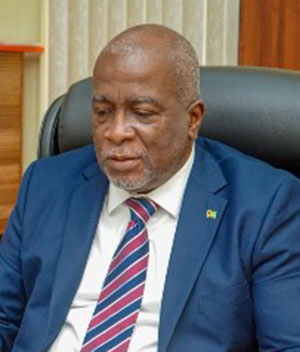Prime Minister Mark Phillips yesterday defended the government’s decision to seek a three-year supply of 50 megawatts of power utilising Heavy Fuel Oil (HFO).
He said that the government did not want to be saddled with HFO generators as it transitions to natural gas by 2025 and this is the reason it is opting to rent generators for three years.
His position was echoed by Guyana Power and Light (GPL) Chief Executive Officer (CEO), Bharrat Dindyal who also explained that Guyana’s current generation systems are not designed for renewables, except for hydropower and that cannot be provided in the short-term.
“In addition to the Wartsila engines, there are still a lot of old engines. So in order to maintain short-term stable and reliable electricity supply… they have estimated they will need 50 MWs more. This is until gas to shore supply kicks in the three years and we have the continued transition to that [gas to shore] and renewable energy,” Phillips told Stabroek News.
On Friday, GPL invited Expressions of Interest (EOI) for the supply of 50 Megawatts of HFO-generated power by Independent Power Producers (IPP).
In an advertisement in Stabroek News, GPL says this supply is needed by March 2023 for three years; putting the end of the contracted period to March 2026.
“Three years is the short term and then the gas to shore, which is transitional energy will come on stream and we will get just about 300 megawatts from that. But between now and then, we want to have all assurance that we have stable, adequate and reliable electricity,” Phillips said.
The invitation will raise concerns for a number of reasons. The resort to HFO comes amid the ongoing global climate crisis and the need to phase out heavy carbon pollutants in line with Guyana’s commitments. HFO is a serious pollutant.
Second, the notice would indicate that the government’s plan for the introduction of offshore natural gas into the energy mix is at least three years away. Third, the last purchase of HFO generators from Finland’s Wartsila was seen as sufficient for current needs pending diversification to green sources such as hydro, solar and wind. These generators recently encountered difficulties but are now back in service.
Phillips said that one must understand that Guyana’s power generation and distribution system transitioning to renewable power in the short term isn’t “just a switch on and switch off” process and the choice is to accommodate and meet the requirements of what can currently be used.
He emphasized that Guyana is still committed to its transitioning commitments and important for this country was that it sources a provider who can ensure that the generation capacity needed is provided.
The Prime Minister pointed out that with growing development plans, projection generation was necessary to ensure that citizens can be given reliable power supply. “In the short term, we recognize we will need 50 megawatts,” he noted.
The advertisement says that the total 50 MW of generation capacity shall be divided into two lots of 25 MW. The earmarked 69 kV substations for interconnection are New Sophia and Canefield. Proponents are invited to explore the options of a power barge and land-based facilities.
Potential IPPs shall be responsible for all activities – fuel storage tanks, fuel, water treatment, testing, commissioning, operating and maintaining the power generation facility, the advertisement said.
GPL’s CEO shared similar views as he pointed out that the generation systems will be rented and explained that the forecast demand will require additional generation over what is currently being produced.
“We are renting. We are looking for dispatchable capacity; meaning we can use it whenever we so desire. Renewable would not fit that unless it is hydro and the time doesn’t allow that,” Dindyal said.
He, too, emphasized the plans for transitioning in the future but stressed that the three-year demand being forecast by the utility company “would require we have additional capacity”.
Expressions of Interests for the project must be submitted by May 6, 2022.






